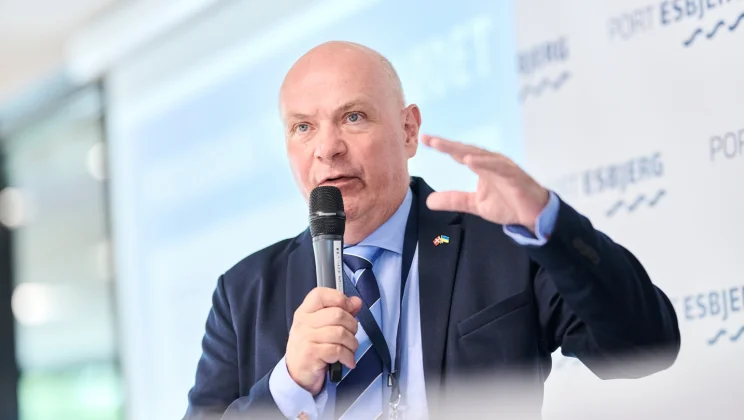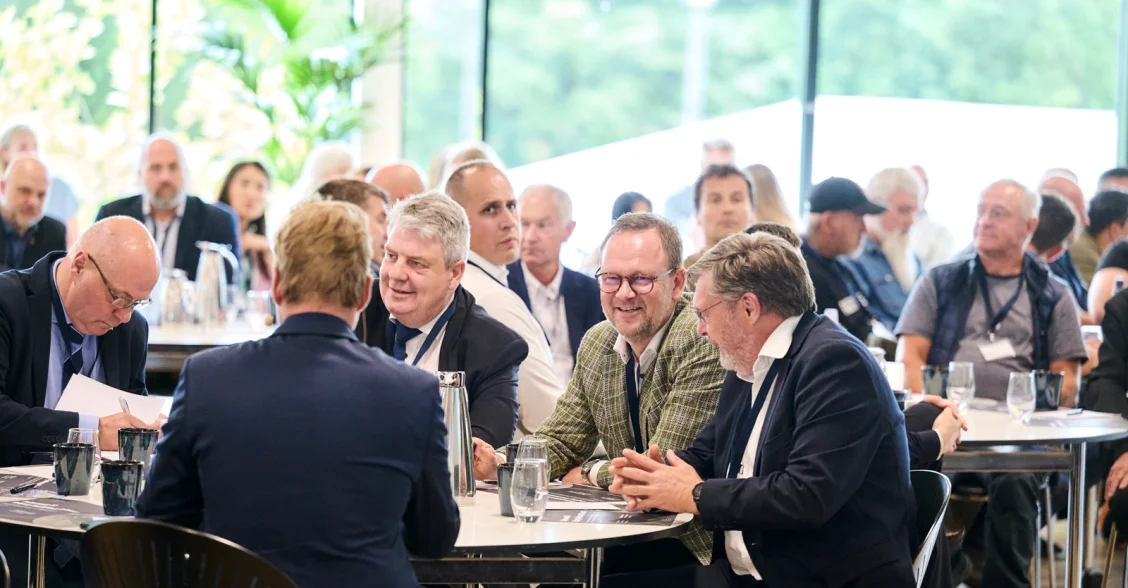Port Esbjerg held its Annual Meeting at the Blue Water Arena, sharing good news about revenue, profit and exciting prospects.
It was a day of new records when Port Esbjerg held its Annual Meeting on Friday, 6 June at the local Blue Water Arena.
The first record was set even before Port Esbjerg’s Annual Meeting 2025 kicked off: 138 people had registered – a record-high number, which also challenged the kitchen a bit with keeping the buffet replenished for the hungry attendees.
This year’s Annual Meeting was organised in collaboration with the multi-platform publication Søfart, and its editor-in-chief Nicolai Østergaard welcomed the record-high number of attendees.
In addition to the annual review provided by Chairman Søren Gade, the Mayor of Esbjerg and Vice Chairman of the Board, Jesper Frost, spoke about Esbjerg as a leading climate and energy city. Michael Johannes Koch, Associate Professor of Economics at Aarhus University, gave a presentation of Denmark as an export nation in a new geopolitical reality. Then journalist and commentator Thomas Larsen spoke briefly before all speakers engaged in a panel debate on the role of ports in the new geopolitical reality.

Søren Gade, Chairman of the Board, delivered his address at the Annual Meeting, highlighting the port’s activities and results in 2024 as well as future perspectives.
Chairman sees great prospects
Chairman of the Board Søren Gade presented Port Esbjerg’s best-ever financial results. Read more here.
But he stressed that the strong bottom line was not the reason why he was so pleased.
“I’m thrilled because all of you here today are here as part of a positive common narrative. A narrative about a port that has flourished quite unbelievably. About a city that dares to seize opportunity. And about a business community that has proven what can be achieved by working together – with direction and ambition,” said Gade.
He then summed up some of the highlights of the past year.
Port Esbjerg completed the deepening of the fairway to 12.5 metres. It also completed the extension of the rail freight terminal, leading to an increase in rail transport from all over Europe. It expanded the port area by more than 575,000 square metres, an increase of just over ten per cent, and handled an extra 12,000 cars. Port Esbjerg also increased the occupancy rate of the port’s warehouse and shipping areas and began the construction of Denmark’s first CO2 terminal for storage in the North Sea.
“2024 was not just a year of growth. It was a year of transformation,” he said.
He continued:
“Port Esbjerg has become a hub – for green energy, international logistics and European security.”
Last year, Port Esbjerg invested EUR 54.53 million in expansion and maintenance.
“We did that because we take a long-term view. We recorded growth in wind turbine cargo, bulk, container and cars as well as increased demand for space.”
Gade then went on to talk about new US tariffs on green technologies. With Donald Trump as the United States president, uncertainty about the future has increased significantly, and plans have been made for 100 per cent tariffs on certain European products.
“It may sound bizarre and far away from Esbjerg. But it’s not. Because Esbjerg depends on free trade, stable frameworks and global coordination. That’s what makes us attractive,” said Gade. And he stressed the need for the EU to stay on course and prioritise green energy, ports and security of supply – with even more political force.

The 138 registered participants in the Claus Sørensen Lounge at Blue Water Arena shortly before the Annual Meeting officially began.
NATO is expected to generate more calls and stronger emergency measures
Given his legacy as Minister of Defence from 2004 to 2010, Søren Gade has a special focus on Esbjerg as a NATO port. He touched on that as well.
“Port Esbjerg also took major steps in another area in 2024 due to its growing role as a NATO port. Last year, we recorded more calls, stronger emergency measures and stricter requirements for logistics and infrastructure. This means that we can no longer regard Port Esbjerg as just an energy port. Port Esbjerg is also critical infrastructure for Europe’s security,” he said.
Gade also stressed that security will play an increasingly important role at the port, and not least that it is expected to generate more jobs for the port companies. He added that concrete physical changes and the use of underwater drones are also being considered in order to further secure the port.
Port Esbjerg is building a bridge
With the deepening of the fairway, Esbjerg became one of only a handful of European ports offering similar capacity and facilities.
“We are building a bridge – between Esbjerg and Europe. Between the past and the future.
He thanked the port companies, the local authority and the employees working at the port.
“In 2024, I said we would be busy. And indeed we were. In 2025, I say: It’s going well, but we’ve still only just begun. The coming years look set to bring Port Esbjerg to even greater prominence,” he said.
Geopolitical challenges and opportunities
The next speaker, Michael Johannes Koch, Associate Professor of Economics at Aarhus University, spoke on the impact of geopolitical changes on the economy. He concluded that changes are indeed afoot, and we will see less trade with the United States. But, in his opinion, that would be compensated for by more trade in existing and new markets, such as India.
“Now that you mention India, Michael. We just had visitors from Mumbai wanting to learn about shore-to-ship power, CO2 reductions and storage of CO2 in the North Sea. These areas hold great potentials for exports in the future,” Gade picked up.
The discussion then turned to China as a challenge.
“We need our Ministry of Foreign Affairs to take a strong proactive approach for companies to establish themselves in new markets. China is highly skilled and does not always play entirely by the rules,” said Thomas Larsen.
Søren Gade said that he believed globalisation is unravelling.
“But for small markets and companies in Esbjerg, opportunities are still abundant,” he said, before making his final point:
“I feel extremely optimistic for Port Esbjerg.”
Go to overview

